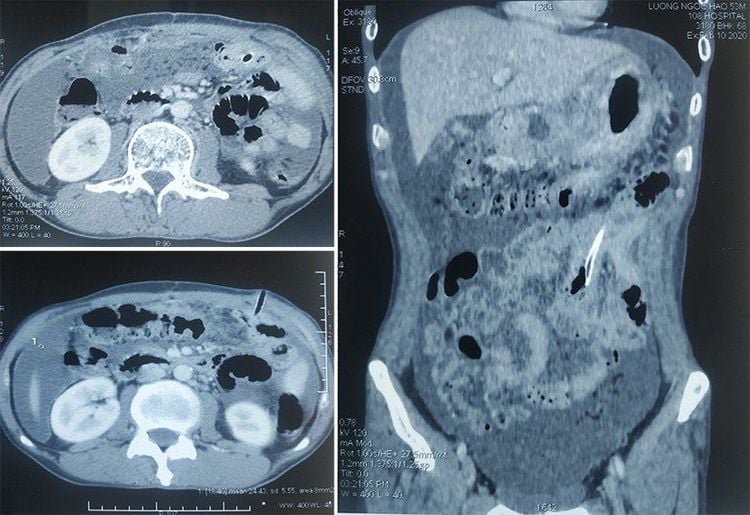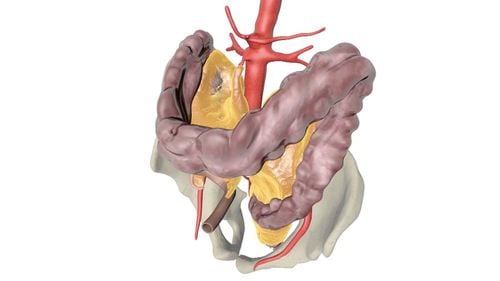This is an automatically translated article.
Peritoneal cancer is a rare cancer. Peritoneal cancer is often detected at an advanced stage because the symptoms are not obvious in the early stages, making it difficult to diagnose.1. What is peritoneal cancer?
The peritoneum is made up of epithelial cells, which play a protective and protective role for the abdominal organs including the intestines, bladder, rectum and uterus. At the same time, the peritoneum secretes mucus to help organs move easily in the abdomen.Peritoneal cancer is formed in the thin layer of epithelial cells that line the inner wall of the abdomen. Peritoneal cancer is classified into 2 types depending on the site of onset:
1.1 Primary peritoneal cancer Primary peritoneal cancer is cancer that develops in the peritoneum, usually only occurs in women and very rarely in men.
A rare form of primary peritoneal cancer is peritoneal malignant mesothelioma.
1.2 Secondary peritoneal cancer Secondary peritoneal cancer: Also known as peritoneal metastatic cancer, most of the time, it usually starts from the primary cancer in the abdominal organs, then metastasizes. metastases to the peritoneum such as: ovarian cancer, fallopian tube cancer, stomach cancer, colon cancer, rectal cancer, bladder cancer,...
Secondary peritoneal cancer can occur occurs in both men and women and accounts for a higher rate than primary peritoneal cancer. Metastatic cancer cells will be of the same type as the cancer cells at the site of origin.
2. What is the relationship between primary peritoneal cancer and ovarian cancer?
Primary peritoneal cancer is very similar to advanced carcinoma of the ovary, both involving the same cell type. Therefore, the treatment and life expectancy of these two cancers are similar.Differential diagnosis for peritoneal cancer if:
Ovarian normal Cancer cells are not present on the surface of the ovary The tumor type is mainly serous (mucus-producing)

Ung thư phúc mạc là một bệnh ung thư hiếm gặp
3. Causes of primary peritoneal cancer and risk factors?
The cause of peritoneal cancer is currently unknown. Some risk factors for peritoneal cancer include:Age: The risk of peritoneal cancer increases with age Genetics: A family history of ovarian or peritoneal cancer or being in a person with a genetic mutation BRCA1 and BRCA2 . Hormone therapy: Taking hormone therapy after menopause also slightly increases the risk of peritoneal cancer. Overweight or obese. Endometrial optimism .
4. Symptoms of peritoneal cancer?
Symptoms of peritoneal cancer depend on the type and stage of the disease. In the early stages, the patient may have no symptoms, or have vague initial symptoms, similar to many other diseases. By the time obvious symptoms occur, the disease is usually advanced. Symptoms of peritoneal cancer include:Abdominal bloating or pain, an enlarged abdomen, and a feeling of pressure in the abdomen or pelvis. Feeling full, even after a snack Nausea or diarrhea Constipation Loss of appetite Frequent urination Unexplained weight loss or gain Rectal bleeding, unusual vaginal bleeding Fatigue, back pain. As peritoneal cancer progresses, mucus can build up in the abdominal cavity (ascites) and cause nausea or vomiting, shortness of breath, abdominal pain, and fatigue. In the late stages, there may be complete bowel or urinary obstruction, abdominal pain, inability to eat and drink, and vomiting.
5. How is peritoneal cancer diagnosed?
It is difficult to diagnose both primary and secondary peritoneal cancer in the early stages because there are no clear and specific symptoms. Besides taking the symptoms and history, tests that may be ordered to diagnose peritoneal cancer include:Ultrasound, CT scan of the abdomen and pelvis to detect ascites or growths. tumor. Blood test to determine the level of CA-125 (a substance made by tumor cells) in the blood. If this substance is in high concentrations, peritoneal or ovarian cancer may be suspected, however, this test is not specific. Lower GI (gastrointestinal) or barium enema uses X-rays to see the location of tumors and other problems in the colon and rectum. Upper GI to look at problems in the esophagus, stomach, and duodenum. Biopsy. Amniocentesis: In the absence of surgery to remove cells for biopsy or due to distended ascites, abdominal fluid can be obtained for microscopy.

Phương pháp điều trị ung thư phúc mạc trước tiên là phẫu thuật cắt bỏ tất cả các tổn thương nhìn thấy được
6. How is peritoneal cancer treated?
Primary peritoneal cancer is treated like ovarian cancer. Treatment for primary and secondary peritoneal cancer varies for each patient, depending on the stage of the disease, the size and location of the tumor, and the patient's health status. Specific treatments include:Surgery: Surgery is usually the first step, the doctor will try to remove all visible lesions. At the same time, the ovaries, fallopian tubes and uterus and other tissues and organs may also be removed depending on the condition. Chemotherapy: Patients may receive chemotherapy treatment to shrink the tumor before removal or use it after surgery to kill any remaining cancer cells. HIPEC (Intraperitoneal temperature-raising chemotherapy): A technique that uses heat in combination with direct chemotherapy into the peritoneum. Targeted therapy: Using targeted drugs such as monoclonal antibodies, PARP (poly-ADP ribose polymerase) inhibitors that block DNA repair, angiogenesis inhibitors that block growth of blood vessels in the tumor. Palliative Care: Peritoneal cancer is often found at an advanced stage, so supportive care can help relieve symptoms of peritoneal cancer such as pain, weight loss, or edema.
7. How long does peritoneal cancer live?
The prognosis of patients with primary or secondary peritoneal cancer has greatly improved in recent decades thanks to advances in treatment. However, because peritoneal cancer is often detected at a late stage and because of the high rate of recurrence, patients often need further treatment afterward.Please dial HOTLINE for more information or register for an appointment HERE. Download MyVinmec app to make appointments faster and to manage your bookings easily.
Reference sources: Webmd.com, healthline.com, cancerresearchuk.com












